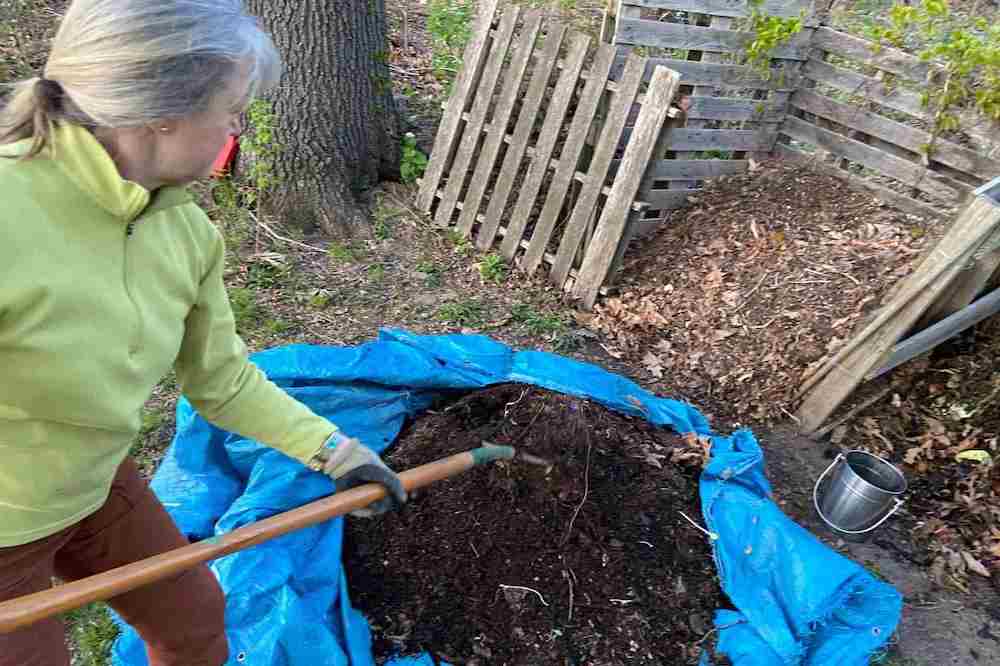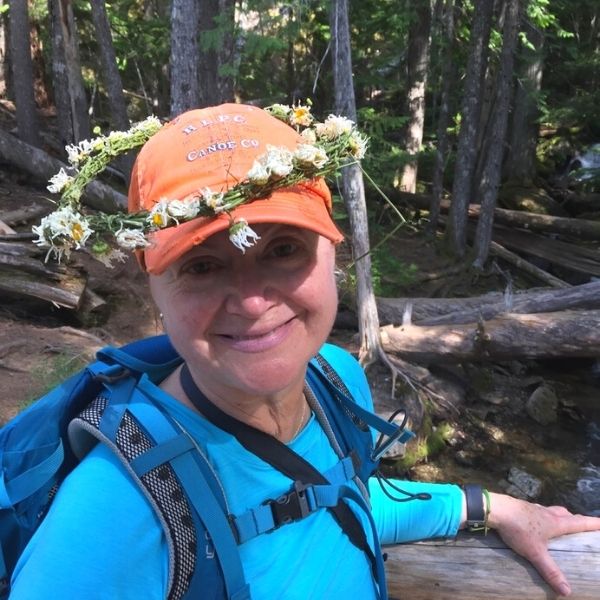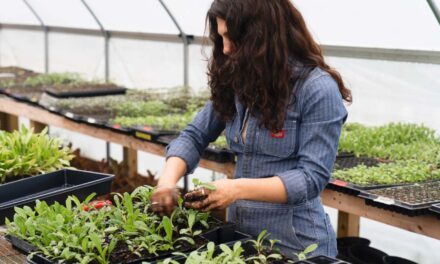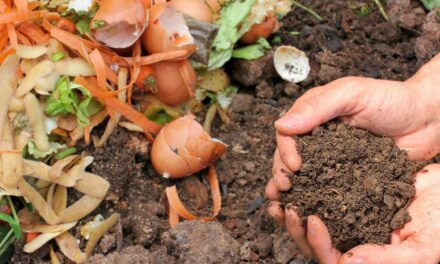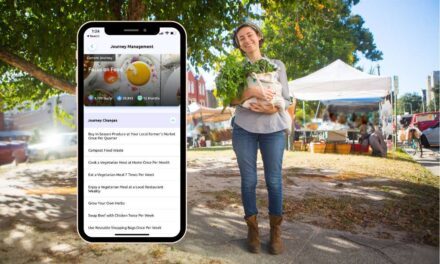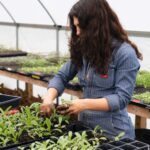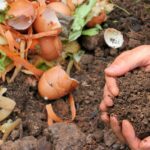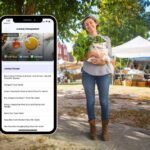Backyard composting is rewarding and beneficial for the planet.
Backyard composting makes me feel really good, as I know I am reducing the amount of trash my household sends to the landfill. While it may seem like a small Joyful Change, composting can have a huge impact for our gardens and the planet.
When food waste begins to rot in a landfill, it creates methane emissions, which are more potent than carbon dioxide. When food waste naturally rots under the right conditions, it creates a powerful compost material that can enhance your soil’s nutrients. I use nourishing compostable materials to fertilize my garden, which also boosts the nutritional benefits of the produce I grow.
Imagine the impact we could have if we all committed to composting our food waste! We could reduce the trash in our landfills and grow amazing flowers and gardens for all to enjoy. Here is an easy guide to backyard composting to help you on your journey to live more sustainably.
Food scraps and yard waste make up more than 30 percent of what we throw away. They could be composted instead.
According to the Environmental Protection Agency (EPA), “Making compost keeps these materials out of landfills where they take up space and release methane, a potent greenhouse gas.” Peelings from vegetables and fruit, coffee grounds, leaves and grass — plus water — makes a wonderful concoction that replenishes the soil. It is economical and easy to do.
What is composting?
Composting is the process of recycling decomposing (rotting, decaying, disintegrated) matter back into soil. Food scraps break down amongst dried leaves, grass, discarded plant-based and cellulose fiber materials into nutrient rich dirt. Composting speeds up the process by helping bacteria and fungi grow. Other microorganisms, earthworms, and insects aid in the decomposing work. As Janine M. Benyus writes in The Field Guide to Wildlife Habitats of the Eastern United States, “There are entire worlds to explore in every teaspoon of soil.” Once the cycle is complete you will have what gardeners call “black gold.”
All that is required to transform compost into a nutrient-rich humus is nitrogen, carbon, water, and air.
Composting is very beneficial in breaking down matter into a nutrient-rich soil that smells incredibly good. You may have noticed when taking a hike in the woods an earthy or woodsy smell. What you are smelling is the breakdown of organic material, also known as humus. Seeds, root fragments, and plants thrive in this material.
Composting has many benefits:
- Saves energy
- Reduces pollution
- Reduces the amount of waste that is sent to landfills and Waste to Energy (WTE) facilities
- Fosters an environmental ethic among citizens
- Increases carbon sequestration of natural resources
The History of Composting
According to Stu Campbell, decomposition is at least as old as the soil itself. Long before people were around to observe it, natural composting has been going on in every forest, meadow, swamp, bog, prairie, and grasslands around our planet. Campbell acknowledges poet Walt Whitman who stated, ‘The earth itself is something of a compost pile. It gives such divine materials to men, and accepts such leavings from them at last.” Our ancestors were the true discoverers of organic gardening, writes Campbell. “Only by trial and error were they able to learn what worked when it came to making synthetic manure. They didn’t have anyone to guide them or give them good advice because there was nobody around who knew very much.”
My Composting Experience
I have been composting since 1988 when my husband and I purchased our first home in Central New York. We had about 1.25 acres of land with fields and forests beyond our property line. We inherited an asparagus and strawberry patch on the property, which really piqued my interest in gardening. Composting is something I did all year long, although at the time I saw it as a way to lessen the trash we sent to the landfill. I did not realize until later how nutrient-rich and beneficial it was to our soil. In that same year of 1988, the New York State Legislature established our State Solid Waste Management Policy which enlightened me more about the benefits of reducing our own solid waste materials.
My Backyard Composting Journey
In my early days of home ownership, my backyard compost pile certainly did heat up but sadly went unused. The only ones who used that compost pile were the reptiles who loved to bask in the warmth on top of it. I did not realize until later how beneficial that “black gold” is. The by-product of all of those carbon- and nitrogen-rich materials would have been such a great addition to my garden’s soil.
One day, I was invited to visit an organic farm and my eyes were opened to the benefits of composting. I learned how to mix different types of soil amendments along with composting to boost my garden without the use of pesticides and herbicides. As I planted several garden beds over the years, each time I would have to dig down into the shale rock and clay. It was hard work but I enjoyed it. Composting is a great way of organically helping to break up the clay matter as it helps to drain and aerate.
The formula for a successful compost is to mix two parts green to one part brown material.
Nitrogen (N)-rich plants (green) such as grass clippings, fruit and vegetable peels, coffee grounds, and ground up rinsed egg shells.
Carbon (C)-rich plants (brown) such as small twigs, dried leaves, and shredded newspaper/brown paper bags.
Potassium (K)-rich organic sources such as coffee grounds and potash (wood ashes from leftover wood fires from a fireplace or stove). Ashes from banana skins, lemon skins, cucumbers, and cocoa shells are also good sources. I usually just chop them up and add without burning. Potassium is also a component in fertilizer.
You can choose whether to layer these materials periodically or chop them up together with a lawn mower. Breaking the materials down into smaller pieces will help them decompose more quickly.
You may find that you need to adjust this formula if your compost is smelling or attracting flies. If it is not decomposing quickly, simply add more green material. If your compost looks mucky or has a bad odor, add more brown material.
Very Important! Never add bones, dog/cat waste, cooked kitchen scraps, dairy products, diseased plants, treated grass clippings, weeds with seeds, or meat to your compost pile. This spells disaster as they will attract animals like mice to your compost.
There are several ways to compost depending on how involved you want to be.
- FoodCycler electric composter
- At-home composting using the Bokashi composting, worm composting, garden compost, and chickens to use up all of our food scraps and eventually return those nutrients to the soil.
- Compost rotary bins
- Mixing municipal pick up and a compost bin at home
- Composting on a small urban garden plot
- Community compost pick up programs
I personally use several composting methods.
I have a small stainless steel countertop container which is filled with kitchen plant-based scraps, ground coffee, and crushed egg shells mixed with a little water. Once it is filled, the scraps are taken to two to four pallet bins in the backyard, in a partially sunny area where the compost can heat up. The left side of the first pallet has the old compost ready to go into the garden while the second one has the newer material that needs to break down. These are rotated as I use them. I try to make sure that the compost is moist but not saturated. I aerate it by tossing it occasionally with a pitch fork. This “pile up” or “lasagna” method was how I first began composting. It takes a while to decompose when left on its own, as it takes longer to heat up, but it’s still an effective method.
For Mother’s Day one year, I received a rotary composting bin from my son. Similar to a garbage barrel, this tumbler is really convenient and is portable. I simply add collected raw materials into the bin and them mix and aerate them by sealing the bin and turning the tumbler.
If your interest has piqued, I would highly recommend, Let It Rot, The Gardener’s Guide to Composting by Stu Campbell or No Waste Composting by Michelle Balz. They are very informative books on all aspects of composting.
An easy way to start composting is by using a service near you. Find a composting site near you.
This experience was shared by OPL Naturalist Yvonne Dwyer.
Learn more about Yvonne.

